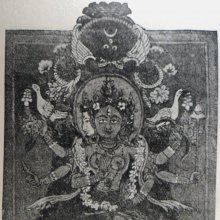Mahashitavati, Mahāśītavatī, Maha-shitavati: 6 definitions
Introduction:
Mahashitavati means something in Buddhism, Pali, Hinduism, Sanskrit. If you want to know the exact meaning, history, etymology or English translation of this term then check out the descriptions on this page. Add your comment or reference to a book if you want to contribute to this summary article.
The Sanskrit term Mahāśītavatī can be transliterated into English as Mahasitavati or Mahashitavati, using the IAST transliteration scheme (?).
Images (photo gallery)
In Buddhism
Tibetan Buddhism (Vajrayana or tantric Buddhism)
Source: archive.org: The Indian Buddhist Iconography1) Mahāśītavatī (महाशीतवती) refers to one of the various (female) emanations of Amitābha having their Sādhana described in the 5th-century Sādhanamālā (a collection of sādhana texts that contain detailed instructions for rituals).—Her colour is red; her Āsana is the ardhaparyaṅka; She has four arms.—All the five goddesses constituting the Pañcarakṣā group are said to emanate from one or another of the Dhyāni Buddhas. Mahāśītavatī is affiliated to her parental Dhyāni Buddha Amitābha.
The Dhyāna (meditation instructions) of Mahāśītavatī described in the Sādhanamālā as follows:
“Mahāśītavatī is four-armed, one-faced, and red in colour. She shows in her two right hands the rosary and the varada pose, and in her two left hands the vajra and the Book against the chest. She originates from the syllable ‘Jīṃ’, bears the effigy of Amitābha on the crown, sits in the ardhaparyaṅka attitude, and is decked in various ornaments. She sits on the orb of the sun and glows like the sun”.
2) Mahāśītavatī (महाशीतवती) refers to one of the five Protector Goddesses (Rakṣa or Pañcarakṣa), commonly depicted in Buddhist Iconography, and mentioned in the 11th-century Niṣpannayogāvalī of Mahāpaṇḍita Abhayākara.—Her Colour is red; her Symbol is the lotus; she has three faces and eight arms.— The fourth deity in the series of five Rakṣā goddesses is named as Mahāśītavatī to whom the western direction is assigned.
Mahāśītavatī is described in Niṣpannayogāvalī as follows:—
“In the West on the orb of the sun on a double lotus there is Mahāśītavatī sitting in the Ardhaparyaṅka attitude with the halo of of the sun. She is red in colour, and her faces show the red, the white and the blue colour in the first, the right and the left faces respectively. She is eight-armed. In the four right hands she displays 1. the lotus with the abhaya-mudrā, 2. the arrow, 3. the vajra and 4. the sword. In the four left hands she shows 1. the noose with the tarjanī, 2. the bow, 3. the jewel banner and 4. the manuscript against the chest”.
The Sādhanamālā describes Mahāśītavatī as six-armed and green in colour. She is widely represented in Buddhist countries. Under the title of Śītavatī she is known to the Chinese collection.

Tibetan Buddhism includes schools such as Nyingma, Kadampa, Kagyu and Gelug. Their primary canon of literature is divided in two broad categories: The Kangyur, which consists of Buddha’s words, and the Tengyur, which includes commentaries from various sources. Esotericism and tantra techniques (vajrayāna) are collected indepently.
General definition (in Buddhism)
Source: Cambridge Digital Library: Pañcarakṣā, SaptavāraMahāśītavatī (महाशीतवती) refers to the last of “five protections” (pañcarākṣa) classified as a dhāraṇī according to a 17th-century Sanskrit manuscript from Nepal .—The earliest evidence for texts grouped together as the “five great dhāraṇīs” comes from Tibetan catalogues around 800 CE. These scriptures include spells, enumerations of benefits and ritual instructions for use.
Languages of India and abroad
Sanskrit dictionary
Source: Cologne Digital Sanskrit Dictionaries: Edgerton Buddhist Hybrid Sanskrit DictionaryMahāsitavatī (महासितवती).—name of a rakṣā, q.v.: Sādhanamālā 401.5 etc.; the v.l. °śītavatī occurs 402.9; 408.18; = Śītavatī, q.v.
Source: Cologne Digital Sanskrit Dictionaries: Monier-Williams Sanskrit-English Dictionary1) Mahāśītavatī (महाशीतवती):—[=mahā-śīta-vatī] [from mahā > mah] f. (with Buddhists) Name of one of the 5 gr° tutelary goddesses (See mahā-rakṣā), [Buddhist literature]
2) [v.s. ...] (mahā-śetav, [Horace H. Wilson])
[Sanskrit to German]
Sanskrit, also spelled संस्कृतम् (saṃskṛtam), is an ancient language of India commonly seen as the grandmother of the Indo-European language family (even English!). Closely allied with Prakrit and Pali, Sanskrit is more exhaustive in both grammar and terms and has the most extensive collection of literature in the world, greatly surpassing its sister-languages Greek and Latin.
See also (Relevant definitions)
Partial matches: Sitavati, Maha.
Full-text: Mahashetavati, Pancaraksha, Sitavati, Maharaksha, Pancarakshamandala, Raksha, Mahamantranusarini.
Relevant text
Search found 1 books and stories containing Mahashitavati, Mahāśītavatī, Mahā-śītavatī, Mahāsitavatī, Mahasitavati, Maha-shitavati, Maha-sitavati; (plurals include: Mahashitavatis, Mahāśītavatīs, śītavatīs, Mahāsitavatīs, Mahasitavatis, shitavatis, sitavatis). You can also click to the full overview containing English textual excerpts. Below are direct links for the most relevant articles:
The Indian Buddhist Iconography (by Benoytosh Bhattachacharyya)
